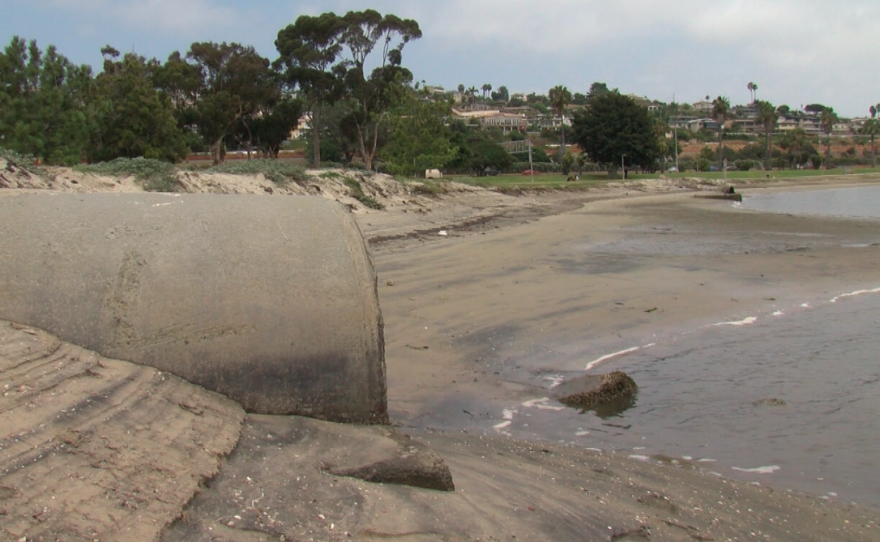For the second time in the past year, city planners are poised to unveil redevelopment alternatives for the northeast corner of Mission Bay. Interested parties are scrambling to make sure their interests remain part of the plan.
The Kendall-Frost Marsh, just north of Crown Point, is a preserved slice of San Diego's past.
Kendall-Frost Marsh, a sliver of wetlands tucked along the northeast portion of Mission Bay, represents the last of what used to be thousands of acres of salt marsh. City officials stripped away that habitat over three decades as they created the nation's largest aquatic park.
The Kendall-Frost Marsh sits right beside a recreational vehicle park, Campland on the Bay. The recreational vehicle park is a nod to the city's commitment to maximizing recreational uses along the man-made bay's waterfront.
"This is a place where families introduce their kids to the importance of protecting the natural environment. Campland on the Bay has co-existed successfully with the existing Kendall Frost Marsh for decades now," said Jacob Gelfand, project director at Campland on the Bay.
But Campland's location is problematic.
The RV park separates the existing marsh from Rose Creek. That stream should funnel sediment and water into the wetlands but it flows through a channel directly into the bay.
City officials recognized the park's shortcomings when they hammered out a master plan for the bay in the mid-1990s. The Mission Bay planning document calls for the Campland site to be turned back into natural habitat when the facility's lease expires. A three-year extension means that happens in 2020 unless the city chooses to give the business up to two additional one-year extensions.
"Campland on the Bay is an important economic driver for the city of San Diego contributing nearly $3 million a year in lease and tax revenue for the city and providing over 150 jobs," Gelfand said.
The park's $70 a night camping fees are significantly cheaper than other vacation spots along the water in California. The city needs affordable accommodations on the bay, according to Campland supporters.
Gelfand would like to keep the park where it is, but he has already lobbied city officials to move to the other side of Rose Creek. That is where the De Anza Cove mobile home park used to be. A long and expensive legal fight with the city has finally emptied the trailer park and Gelfand sees an opportunity to take over the now largely abandoned property.

"The Mission Bay Park master plan recommends that in the event that the use of Campland's existing site was to change the peninsula of De Anza Cove would be an ideal location to transfer Campland's lease potentially and to continue providing affordable waterfront camping. In part, because historically both this site and the peninsula of De Anza have been used to provide affordable overnight accommodations and waterfront recreation," Gelfand said.
The master plan actually says Campland "could" move to De Anza Cove but city officials have said publicly that the master plan does not provide specific guidance for the area.
The De Anza peninsula and cove are also coveted by environmentalists who see this as prime property for the return of Mission Bay's traditional salt marsh habitat.
"So everything you're seeing here is man-made," said Rebecca Schwartz Lesberg, of the San Diego Audubon Society. "This was not a bay and peninsula. This was salt marsh. This was wetlands. If you think of the Tijuana River estuary or up at the North County coastal lagoons, that's what was here."
She leads an effort called Re-Wild Mission Bay. The Audubon Society group wants to soften the human footprint on this part of the bay.
Currently, storm drain outlets foul the water as urban runoff flows into the water. Poor circulation keeps pollution in this part of the bay longer than in other areas.

A sustainable swath of wetlands here could change the dysfunctional man-made ecology. Wetlands would help filter dirty runoff that drains out of nearby neighborhoods.
Since the city is reconsidering the future of the De Anza property, Schwartz Lesberg said the timing is right to re-make this area.
"Right now, almost the entire bay is commerce and recreation and the Re-Wild project would return about five percent of that back to the environment. So still really skewed toward commerce and recreation, but more balanced than it is now," said Schwartz Lesberg.
Environmentalists argue Campland can move its business to any part of Mission Bay, but De Anza is the only place the city can build a sustainable wetland area for people and wildlife.
Camping could still find a home here, it just can not be crowded around the water's edge.
"It actually has to be done correctly where you have a transition of the highest intensity use farther back from the habitat area. So you have things like tent camping and picnic area right next to the beaches or the wetlands and your RV camping or buildings and facilities set farther back," Schwartz Lesberg said.
City officials have been working with the community for more than a year to develop some options.
The city's first round of suggestions was heavy on protecting recreation, but light on expanding the reach of natural habitat.
Re-Wild officials hope the city has revised its approach in its second effort.
But the city is being secretive about those plans.
San Diego officials declined several requests to speak on the record about the process.
The city's communication staff pointed KPBS to a website that outlined the general parameters of the project, but city planners did not want to discuss the project until after its redevelopment options are revealed this week.
The public will get a chance to weigh in at a hearing on Thursday night.






